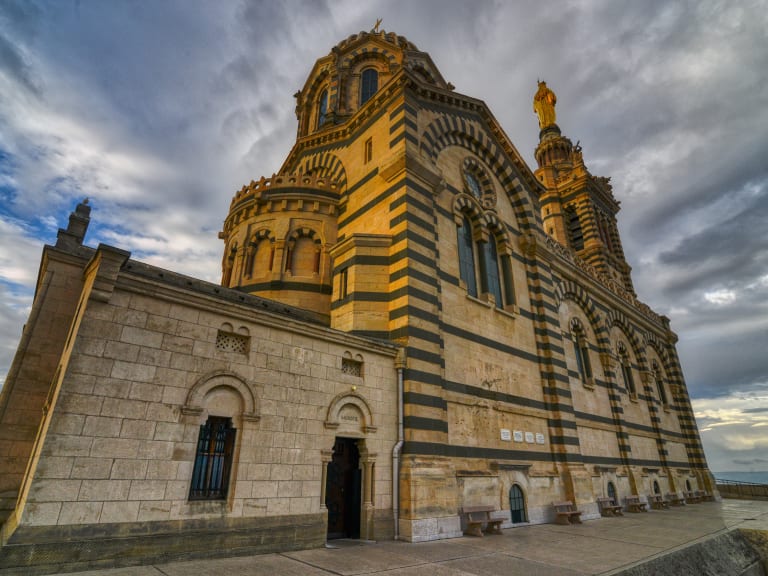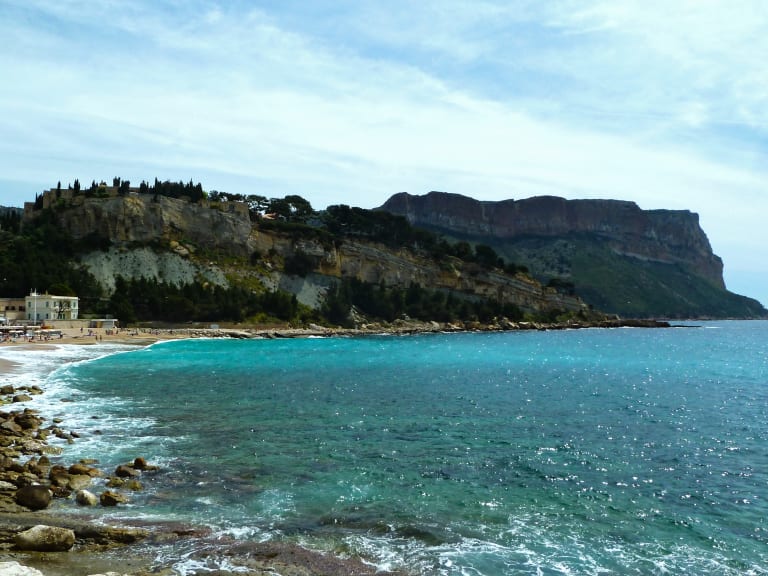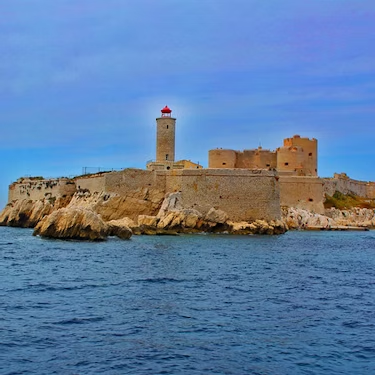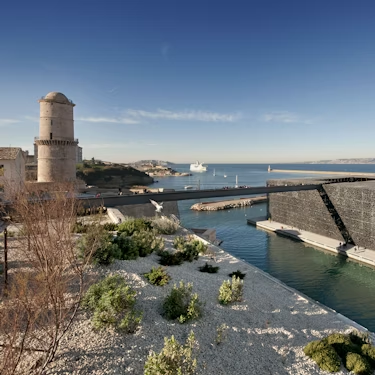More about: Marseille in 4 Days: a guidebook for getting the most out of your visit
Marseille is much more than the second city of France. It is history, art and gastronomy. Four days in the city will allow you to stroll leisurely through the Old Port, get lost in unique neighborhoods such as Le Panier or admire breathtaking landscapes such as the Calanques.
But you will also have time to visit its interesting museums, taste its delicious cuisine and enjoy its lively nightlife. There are endless things to see and do in Marseille. Here is my proposal so you don't miss any of its attractions.
Day 1: the Old Port of Marseille, Le Canebière and If island

The first day in Marseille, yes or yes, you have to dedicate it to the Old Port and its surroundings. This is the real heart of the city.
A millenary heart, but in excellent health, as it is still a fundamental communications hub in the Mediterranean. The best way to discover it? With one of the tours of Marseille.
Fort Saint-Jean
The tour of this first day starts at one end of the Old Port. The Fort Saint-Jean was the first guard and protector of the entrance to the city from the sea. A magnificent fort whose origin dates back to the 12th century, although little is preserved from that time.
But if I recommend starting the visit in this fort it is not only because of its antiquity, but also because it has been the protagonist and witness of great events. It was a defensive enclosure, a prison during the French Revolution and a powder magazine during the Second World War. To know its history is also to know the history of the city.
The Old Port
Before starting the tour of the Old Port of Marseille, a short stop to admire the church of Saint Laurent. It is from the same period as the fort of Saint Jean and the only medieval temple that remains in the city.
From there you just have to walk along the avenue that surrounds the port. On one side you will see small fishing boats and sailboats. On the other side you will find constructions such as the old Town Hall, a 17th century building. But what is really magical is the always lively atmosphere.
A little trick if you want to cross from one shore to another: it is not necessary to go all the way around the port, there are small ferries that cross it every few minutes and that will save you a lot of walking. It is one of the shortest boat trips in Marseille, but also one of the most unique.
Le Canebière
Right in the middle of the port, the great artery of Marseille is born. Le Canebière is an avenue flanked by elegant buildings. It was built in the 17th century and you can admire some of the most beautiful buildings in Marseille, such as the Grand Théâtre, the Opera or the Hôtel Louvre et Paix. Take a look at the facade of the latter, it is really spectacular.
By the way, if you are fond of shopping, this is one of the commercial arteries of Marseille. And if you are hungry at this time of the day, you will find plenty of restaurants where you can try some typical delicacies.
The best way to enjoy the traditional gastronomy is by taking one of the culinary tours around Marseille. But if you want to try it on your own, I recommend the bouillabaisse, which is a fish soup; the poupeton, a fish soufflé; or the aioli, based on cod and vegetables.
Island and Château d'If
For the next visit you have to return to the port and board a boat that will take you to the island of If. It is just outside the port and you've probably heard of it. Here stands a castle that was once a terrifying prison. If you have read The Count of Monte Cristo, by Alexandre Dumas, you can get an idea of what life was like for the prisoners there.
A curiosity: the lower class prisoners were in cells located on the first floor that lacked light. But just a step away, the prisoners of the nobility enjoyed cells with windows and fireplaces. By the way, if you look closely, in some places there are still inscriptions made by the prisoners.
National Theater of Marseille and St. Victor Abbey

Back to the Old Port, there are still places to discover. Continuing along the avenue that surrounds it, you will pass in front of the Soap Museum. It is in a historic soap factory. Inside you will learn how it is made and see a unique collection of soaps.
A little further on you will see the building that once housed the wholesale fish market. Today, its iron and glass facade hides the National Theater of Marseille, better known as La Criée (the auction).
You will not have to walk far to reach the Abbey of St. Victor. It is one of the oldest monuments in Marseille. It is unmistakable for its thick walls and ramparts, which give it the appearance of a castle. It is said that the martyrs of the city, including St. Victor, are buried here.
Fort Saint Nicolas
The visit of this first day in Marseille ends just on the opposite side of the port where it began. Located opposite the fort of St. John, it also had a defensive character, but against the Marseillaise themselves in times of revolt. The views of the harbor from it are wonderful.
Afterwards, nothing like relaxing and dining in the harbor itself. There are a number of establishments, such as Le Bouchon Provençal, where you can try traditional local food, or Une Table au Sud, with a more innovative menu. But if you prefer, there are also bistros and traditional taverns where you will dine in luxury.
Day 2: Le Panier and Palais Longchamp

On the second day of your visit to Marseille, the port remains the direct protagonist because there is still much to see in the surrounding area. Although the day will end a bit far from it.
Museum of European and Mediterranean Civilizations
The recommendation to start the day is to return to the fort of St. John, but to visit the Museum of Civilizations of Europe and the Mediterranean, the MuCEM. It is a really interesting didactic space, so visiting it is one of the best things to do in Marseille with children.
The museum was built on the occasion of the European cultural capital of the city in 2013. Inside it displays a fabulous archaeological collection and hosts interesting exhibitions, as well as meetings and cultural events. It is therefore one of the best museums in Marseille. By the way, do not miss its terrace, the views of the city are spectacular.
Cathedral of Marseille
Its fabulous silhouette stands out like a lighthouse in the lower part of Marseille. Known as La Major, it is unmistakable for its neo-Byzantine architecture, which has nothing to do with that of other French cathedrals. From the outside you will surely be struck by its domes, as well as the Carrara marble and the green Florentine stone in horizontal stripes.
But my advice is that you do not stay only with that image and access the temple. The height of its central nave will take your breath away. And there are many treasures to discover. Look at the marble high altar and the mosaics, they are spectacular. Before leaving, a curiosity: it was Napoleon himself who laid the first stone of the cathedral.
Le Panier and the Vieille Charité
Just behind the cathedral and the port lies a maze of narrow streets and stairways flanked by old Provençal-style buildings. It is Le Panier, the old fishermen's district, a space degraded a few years ago and today one of the most picturesque and multicultural places in Marseille.
My advice is to walk through it unhurriedly because it will surprise you. It is always a lively neighborhood, with a certain hipster touch. Here you will discover countless artisan stores, art galleries, curious graffiti and countless bars and restaurants where you can recharge your batteries tasting gastronomy not only from Marseille, but from all over the world.
And inside you will find one of the essential monuments of Marseille: the Vieille Charité. For centuries, this 16th century building offered help to the most needy. Today it is a multicultural space that houses two museums and that I recommend you visit if you have time.
Longchamp Palace and gardens
To end the day, I advise you to go a little away from the port. The Longchamp Palace is a beautiful half-arched building with a baroque air. Its colonnade, the fountain that rises from it and its waterfall form one of the most beautiful images of Marseille.
The palace houses two museums: the Museum of Fine Arts and the Museum of Natural History. You can visit them, they are really interesting. Or you can stroll through the gardens behind the palace, which are a real oasis.
The Longchamp Palace has a curious history. The reason for its construction was to celebrate the end of the construction of the Durance canal, which brought drinking water to the heart of the city. Hence the magnificent fountain that decorates it.
Day 3: Notre-Dame de La Garde and the Corniche

On the third day in Marseille you can move a little further away from the center to discover some really fascinating places, many of them overlooking the Mediterranean. To start the day, you can hop on one of Marseille' s tour buses and arrive at the foot of what will be the starting point of your visit.
Notre-Dame de La Garde
If you want to enjoy the best view of Marseille, you must climb the basilica of Notre-Dame de La Garde. From its esplanade you will see the city and the entire bay. Not in vain, it was built on the highest point of Marseille, almost 150 meters above sea level.
It is an elegant and slender basilica, neo-Byzantine architecture, following the style of the cathedral of the city. It was built in the 19th century, although its origin is earlier, as it was built over a medieval chapel. And look at the bronze statue of the Virgin that crowns it, it is no less than nine meters high.
Now a tip: if you can, come back at sunset. You will be able to contemplate two fantastic spectacles. On the one hand, one of the most beautiful sunsets over the Mediterranean. On the other hand, you will see how the white and green of the façade changes color and how the sculpture of the Virgin shines like a lighthouse.
The Corniche
After seeing the panoramic view from the basilica, you have to go down to sea level. The Corniche is a beautiful scenic walkway that runs for five kilometers parallel to the coast. Think it will be strenuous? Don't worry, here is the longest bank in the world, no less than three kilometers long.
The Corniche is worth a walk at any time of the year, but it is one of the best things to do in Marseille in summer. The reason? You can take the opportunity to take a dip in one of its beaches.
Precisely on one of these beaches, Les Catalans, you will find the Underwater Museum of Marseille. If you like to dive into the depths and are looking for things to do in August in Marseille, include it in your plans. The ten sculptures hidden five meters underwater are spectacular.
And a small recommendation: don't pass Vallon des Auffes. It is a small fishing port that still retains its traditional air, with small boats moored and fishermen's houses painted in bright colors. It is one of the most charming corners of Marseille.
Lighthouse Palace
To end the day, the best thing to do is to return to the heart of the city and contemplate the panoramic view from the Lighthouse Palace. You will see the Old Port, the forts of St. John and St. Nicholas, the cathedral and the north coast of Marseille.
It is undoubtedly one of the best postcards you can take away from Marseille. And if you still have some energy left, enjoy the night, the port is one of the most lively places in the city. Move, above all, by quai Rive Neuve or Place aux Huiles, where bars and nightclubs follow one after the other.
Day 4: excursions from Marseille

If you are going to stay four days in Marseille, you can leave the last day for one of the excursions in Provence from Marseille. They are worth it because you will discover places full of charm.
The Calanques
The Calanques National Park is one of the most unique natural treasures of the south of France and is very close to Marseille. It is a 20-kilometer stretch of coastline where beautiful coves are hidden between huge rocky walls.
Some of the best bike tours in Marseille are set in this place. But you can also walk along it at your leisure or even from the sea, on a boat trip.
Cassis and Aix-en-Provence
You can visit them in the same day with a guided tour, but you can also visit them separately. The truth is that each of these places is special. Cassis for its seafaring flavor, its charming harbor and beaches where you can spend a few hours relaxing in the warmer months.
Cassis is a charming little town. Its squares, its palaces, its fountains and its markets will make you fall in love with it. Here you will find all the charm of Provence because surrounding the city you will see lavender fields and vineyards.
By the way, this Aix-en-Provence, besides being the historical capital of Provence, is the city where Paul Cezànne was born. If you like art, you will discover his imprint in countless corners.
Avignon
The papal city is not far from Marseille. Here you can visit the largest Gothic palace in Europe, the unfinished bridge that inspired a famous children's song and other architectural treasures such as the cathedral or the ramparts.
The communication between Marseille and Avignon by train is very good and you can visit the city on your own, but I recommend you do it with a guided tour. Why? Because you will not only discover this beautiful city, the tours usually include a stop in Chatenauneuf du Pape, where you can immerse yourself in the wine tradition of the area.
Luberon
The Luberon Natural Park is a natural area of great value. It also hides some of the most beautiful villages in France. Villages perched on rocky promontories and offering spectacular views. Visiting them will allow you to savor the authentic Provençal essence.
Guided tours usually stop at three of these charming villages: Gordes, Loumarin and Roussillon. There, wonderful markets await you where you can buy some typical Provençal products to take home.
Other excursions from Marseille
The list of places you can visit from Marseille is enormous. It all depends on your particular tastes. One of the best things to do in June in Marseille is to visit the lavender fields. They are in bloom until mid-July.
And, if you like art and history, I recommend a visit to Arles, where you can admire a magnificent Roman amphitheater. Both in this city and in Saint-Remy lived Vincent van Gogh and you can enjoy the landscapes and places that inspired him.




